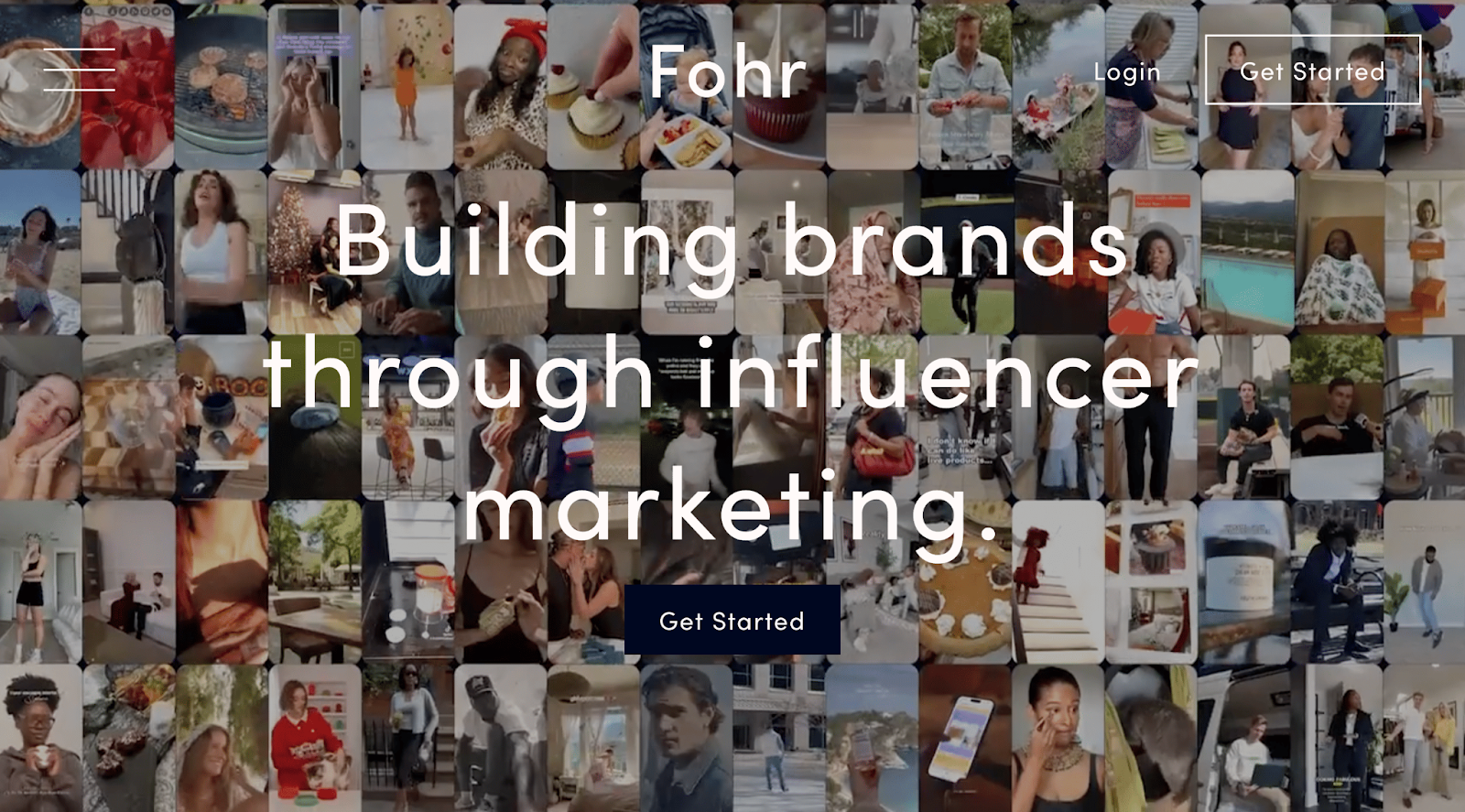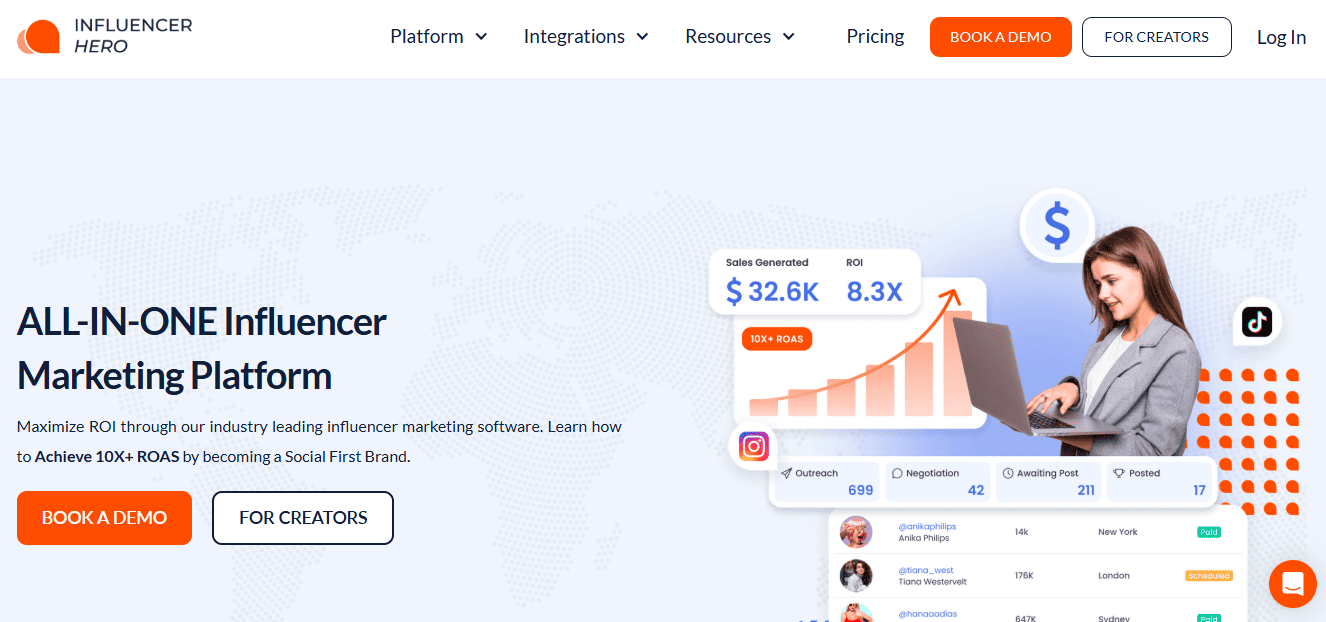


Top 10 Fohr Alternatives: Features, Pricing, and Review [Updated 2025]
Fohr has long been a go-to platform for influencer marketing, but many businesses are now seeking alternatives due to a few notable drawbacks. Users often cite limited customization options for campaigns, challenges with influencer discovery accuracy, and high pricing as major reasons for switching to other platforms.
These issues have led to a growing demand for more flexible and cost-effective tools. As a result, more brands are turning to platforms that offer a wider range of features at a more scalable price point.
Influencer Hero stands out as one of the best alternatives to Fohr. Offering a self-serve platform that excels in influencer discovery, CRM management, and automated outreach, it provides a more accessible and budget-friendly option for smaller teams looking for efficiency without sacrificing quality.
As influencer marketing continues to gain traction, more options are emerging to suit different business needs. According to recent data, the influencer marketing software market is expected to reach $22.3 billion by 2025, with platforms like Influencer Hero leading the way for providing customizable, data-driven solutions for both large and small businesses.
Let’s dive into the top 10 Fohr alternatives that can elevate your marketing strategy:
1. Influencer Hero
2. Modash
3. Upfluence
4. Captive8
5. CreatorIQ
6. HypeAuditor
7. Grin
8. Saral
9. Onclusive
10. MOGL
Why Look For Fohr Alternatives
Here are specific reasons why brands might seek alternatives to Fohr, based on real user feedback:
Limited Creator Pool Due to Opt-In Model
Fohr operates as an opt-in network, meaning you can only access data and collaborate with creators who’ve explicitly signed up with Fohr and connected their accounts. While this guarantees verified metrics, it significantly restricts reach, especially if you're looking for niche or emerging creators outside their ecosystem. (G2)
Limited Volume of Paid Opportunities in Creator Bulletin
Multiple creators report that most listings are unpaid or gifting-only. This may result in reduced interest from experienced influencers, making it harder for brands to attract high-quality talent for paid partnerships.
Occasional Mismatching in Creator Targeting
Some influencers report receiving misaligned campaign invites, like student-oriented campaigns being sent to older creators. For brands, this points to flaws in creator segmentation or targeting logic, potentially leading to lower application quality and more manual filtering during campaigns.
Criteria for Suggesting Fohr Alternatives
Our comparison focuses on several key aspects:
- Social Media Platform Coverage: The extent to which each platform supports major social networks such as Instagram, YouTube, TikTok, Facebook, and Pinterest.
- Reviews: G2/Capterra/Shopify
- Pricing and Commitments: Understanding the cost and commitment levels can help brands choose based on budget and flexibility needs.
- Ease of Use (UX/UI): The overall user experience, including dashboard design, navigation, and onboarding, especially important for teams with limited time or tech support.
- Customer Support: Availability and responsiveness of support channels, including live chat, email, onboarding assistance, and resolution speed for technical or billing issues.
- Key Features: Including influencer discovery, outreach, CRM, reporting, gifting, UGC / content collection, affiliate & payments, storefronts, application page, and AI capabilities.
- Standout Features: Those unique or innovative features that differentiate each platform (e.g. live tracking dashboards, creator benchmarking, TikTok email finders, etc.).
Fohr Overview

Platform Coverage: Instagram, TikTok, YouTube, and Facebook through API integrations.
Best For: Fohr is best suited for brands that want highly verified, opt-in influencers, especially in the U.S. market, and for those looking to manage gifting, UGC, and paid campaigns in one centralized platform.
Pricing: Fohr requires an annual commitment and does not offer a free trial. There are three pricing tiers:
- Essential: $20,000/year for up to 3 users
- Advanced: $30,000/year for up to 6 users
- Premium: $60,000/year for up to 18 users
- Additional users: $5,000/year per user for all plans
Reviews: 5.0 / 5.0 (G2)
Ease of Use (UX/UI): Users generally find Fohr's interface intuitive and straightforward, especially for campaign creation and tracking. The all-in-one workflow from discovery to outreach and reporting is described as streamlined and efficient, though some users note it lacks customization compared to more open-ended CRMs.
Customer Support: Fohr offers dedicated customer success representatives, particularly during onboarding and for campaign support. Users report that the support team is proactive and knowledgeable, assisting with A/B testing, messaging tone, and onboarding strategies.
Fohr Standout Features
- Smart Groups: AI-generated, pre-filtered creator segments like “High Reels Engagement” or “Open to Gifting,” which speed up discovery.
- Bulletin Tool: Allows brands to post opportunities to the creator network; creators can apply voluntarily based on pre-set criteria.
- Integrated Reporting: Real-time, auto-generated reports that break down performance by creator, tier, content, and campaign, differentiating between organic and paid.
- Opt-In Verified Network: Every creator on Fohr has explicitly opted in and connected their platform accounts via API, ensuring authentic data.
- Collaborative CRM Tools: Shared creator lists, internal notes, and shared views across teams for seamless collaboration.
- Content Review & Approvals: Creators upload content directly for brand approval, with downloadable assets for reuse.
- Campaign Brief Templates: Editable briefs that include moodboards, deliverables, creative direction, and even contracts and payment terms.
Fohr Pros and Cons
10 Alternatives to Fohr for Effective Influencer Marketing
Influencer Hero

Platform Coverage: Instagram, TikTok, YouTube, Facebook, Pinterest, Snapchat, X, Twitch
Best For: Influencer Hero is best for D2C brands and eCommerce teams looking to scale influencer marketing campaigns with deep insights, multi-platform support, and automation tools. It's ideal for brands aiming for a high ROI through influencer partnerships across a variety of social media platforms.
Pricing: (Plans are monthly and scalable.)
- Standard Plan: $649/month (Up to 1,000 creators)
- Pro Plan: $1,049/month (Up to 5,000 creators)
- Business Plan: $2,490/month (Up to 10,000 creators)
- Custom & Agency Plan: Custom pricing tailored to brand needs.
Reviews: 5.0 / 5.0 (Capterra)
Ease of Use (UX/UI): Influencer Hero is known for its intuitive design and user-friendly interface. The streamlined dashboard allows for seamless navigation, automated workflows, and customizable email templates, which significantly reduces the time spent on manual tasks.
Customer Support: Customer support is one of Influencer Hero's strongest features. The platform offers 24/7 live chat with real humans, responsive email support, and a comprehensive Help Center with both written and video tutorials. Every plan includes a dedicated account manager from day one, and Pro plan users have access to a private Slack channel for quicker support.
Influencer Hero’s Standout Features
- AI Workflow Optimization: Automates key processes from influencer discovery to outreach, using AI to predict campaign success and suggest next steps.
- Multi-Platform eCommerce Support: Supports integrations with Shopify, WooCommerce, and custom setups, enabling seamless affiliate and gifting tracking.
- Automated, Personalized Outreach: AI-powered email flows help brands connect with influencers, offering a personalized outreach, leading to better conversion rates.
- Chrome Extension: Collect live stats and add influencers directly to your campaigns while browsing platforms like Instagram, TikTok, and YouTube.
- Influencer Brand Followers: Easily find creators who already engage with your brand to ensure authenticity in campaigns.
- CRM: An AI-powered CRM designed for scaling influencer campaigns. It includes automated follow-ups, reminders, and task tracking across large-scale campaigns.
- Gifting & Product Seeding: Automates gift fulfillment for Shopify and WooCommerce integrations, and tracks shipping and delivery confirmations for your eCommerce campaigns.
Influencer Hero’s Pros and Cons
Fohr vs Influencer Hero
Fohr and Influencer Hero both cater to brands looking to scale influencer marketing campaigns, but they differ in several ways. Influencer Hero offers a broader range of features such as AI-driven outreach, a more robust CRM, and integrated eCommerce tools, making it ideal for brands looking for a comprehensive solution. Fohr, on the other hand, operates as an opt-in network and focuses more on community-driven creator outreach with its bulletin tool and limited outreach automation.
Regarding pricing, Influencer Hero provides more flexible plans starting at $649/month for the Standard plan, which is designed for up to 1,000 creators. In comparison, Fohr's pricing starts at $20,000 annually for the Essential plan, making Influencer Hero a more accessible option for brands looking for cost-effective solutions while scaling their influencer marketing efforts.
4. CreatorIQ
Services Offered:
CreatorIQ offers both software and agency services.
Platform Coverage:
Instagram, YouTube, TikTok, Facebook.
Key Features:
CreatorIQ offers a comprehensive set of features, including influencer discovery, CRM, outreach, reporting, gifting, content collection, and affiliate marketing.
Fohr vs. CreatorIQ:
CreatorIQ is presented as a direct competitor to Fohr with a similar breadth of services and platform coverage. It offers a complete suite of tools for influencer marketing, from discovery to payment. The platform is highlighted for its integration with TikTok Creator Marketplace and boasting a strong analytical toolset, which might appeal to brands focused on data-driven decisions. While similar in capabilities, CreatorIQ's distinction may come from its integrations and possibly a more polished user experience based on the minimal public information available, suggesting a platform that caters to high-end or more secretive clientele.
5. Later (formerly Mavrck)

Services Offered:
Later also provides both software and agency services.
Platform Coverage:
Instagram, YouTube, TikTok, Facebook.
Key Features:
Later features influencer discovery, CRM, outreach, reporting & analytics, gifting, content collection, and affiliate marketing. Notably, it integrates with TikTok Creator Marketplace and boasts features for batch content planning.
Fohr vs. Later:
Later distinguishes itself from Fohr through its strong emphasis on content planning and scheduling, especially for Instagram, and its integration with TikTok Creator Marketplace, offering a unique blend of influencer marketing and social media management tools. While Fohr focuses on influencer marketing analytics and partnerships, Later provides a more rounded solution for content creators and brands focusing on visual storytelling and efficiency in content distribution, making it an appealing option for those prioritizing content strategy alongside influencer collaborations.
6. Grin

Services Offered:
Grin offers a SaaS platform but does not provide agency services.
Platform Coverage:
Instagram, YouTube, TikTok.
Key Features:
Grin is strong in influencer discovery, CRM, outreach, reporting, gifting, content collection, and affiliate marketing, with a focus on direct eCommerce integration.
Fohr vs. Grin:
Grin positions itself as a comprehensive influencer marketing platform with a particular strength in its eCommerce integrations, making it ideal for brands that sell online. Unlike Fohr, which offers a broad set of features for influencer marketing, Grin emphasizes the direct connection between influencer campaigns and sales performance, offering tools that can track from outreach to conversion. This focus on eCommerce makes Grin a particularly appealing choice for online retailers and brands looking for a direct ROI from their influencer marketing efforts.
7. Tagger

Services Offered:
Tagger offers a SaaS platform without agency services.
Platform Coverage:
Instagram, YouTube, TikTok, Facebook.
Key Features:
Tagger specializes in influencer discovery, CRM, outreach, reporting & analytics, and affiliate marketing, but it does not offer influencer gifting or content collection.
Fohr vs. Tagger
Tagger focuses on providing a robust platform for influencer discovery and analytics, with powerful search capabilities and detailed insights into influencer performance and audience demographics. While Fohr offers a comprehensive suite of features for influencer marketing, Tagger's absence of influencer gifting and content collection features suggests a prioritization on the analytical and relationship aspects of influencer marketing. For businesses that value deep insights into influencer effectiveness and a streamlined approach to campaign management, Tagger offers compelling functionalities that complement or exceed those found in Fohr.
8. Aspire

Services Offered:
Aspire offers both software and agency services.
Platform Coverage:
Instagram, YouTube, TikTok, Facebook.
Key Features:
Aspire offers influencer discovery, CRM, outreach, reporting & analytics, gifting, content collection, and affiliate marketing, with a strong emphasis on brand-influencer relationships.
Fohr vs. Aspire :
Aspire, similar to Fohr, offers a wide array of features designed to streamline the influencer marketing workflow, from discovery to reporting. However, Aspire sets itself apart with its emphasis on building and nurturing brand-influencer relationships, offering tools that facilitate more personalized engagement and collaboration. While Fohr provides a robust platform for influencer marketing, Aspire's focus on relationship management could make it a better fit for brands that prioritize long-term partnerships and the quality of interactions with influencers.
9. Klear

Services Offered:
Klear focuses on its software platform.
Platform Coverage:
Instagram, YouTube, TikTok.
Key Features:
Klear excels in influencer discovery, CRM, reporting & analytics, but it lacks influencer outreach, gifting, content collection, and affiliate marketing features.
Fohr vs. Klear:
Klear sets itself apart from Fohr by concentrating on influencer discovery and analytics. Without features for influencer outreach, gifting, content collection, and affiliate marketing, Klear focuses on the initial stages of influencer marketing like identifying suitable influencers and analyzing their audience demographics and engagement rates. This specialization makes Klear ideal for brands and agencies emphasizing research and selection in their influencer marketing strategies, potentially offering more detailed analytics compared to Fohr. Klear's niche might appeal to those who prioritize data-driven influencer selection and performance analysis over the broader campaign management tools.
10. Influencity

Services Offered:
SaaS platform only.
Platform Coverage:
Instagram, YouTube, TikTok.
Key Features:
Influencity boasts features including influencer discovery, CRM, outreach, reporting & analytics, gifting, content collection, and affiliate marketing. It's known for its powerful analytical tools and comprehensive influencer database.
Fohr vs. Influencity:
Influencity presents itself as a comprehensive influencer marketing platform, akin to Fohr, with a strong emphasis on analytics and data-driven decision-making. Unlike Fohr, Influencity is celebrated for its depth in analytics and reporting, offering users granular insights into campaign performance and influencer ROI. This platform provides a wide range of features from discovery to affiliate marketing, positioning itself as a robust tool for brands looking for an all-encompassing solution. The key difference may lie in Influencity's advanced analytics capabilities, which could offer more detailed insights compared to Fohr, making it a strong option for brands that rely heavily on data to guide their influencer marketing strategies.
Discovering the Best Fohr Alternatives: A Summary
In the evolving landscape of influencer marketing, platforms like Influencer Hero, Upfluence, CreatorIQ, Grin, and Aspire stand out as top alternatives to Fohr, each bringing unique features to the table. Whether you're looking for direct eCommerce integration, comprehensive analytics, or a blend of SaaS and agency services, there's an option tailored to your needs. This guide has highlighted the strengths and specializations of each platform, helping brands navigate the multitude of choices to find the perfect fit for their influencer marketing strategies.

Top alternatives to Fohr include Influencer Hero, Upfluence, Modash, GRIN, and Captiv8. Influencer Hero is great for smaller businesses due to its AI-powered influencer discovery, CRM management, and automated outreach, offering cost-effective plans.
Influencer Hero offers more affordable and flexible pricing, with plans starting at $649/month, whereas Fohr starts at $20,000/year. This makes Influencer Hero a more budget-friendly option for brands of all sizes.
Influencer Hero leads in automation with AI-driven features for influencer discovery, outreach, and follow-ups. Fohr, in contrast, focuses more on manual, community-driven processes.
Yes, Influencer Hero is ideal for small businesses due to its scalable pricing and self-serve platform. Fohr’s higher pricing and annual commitment make it more suited for larger brands.
Yes, Influencer Hero integrates with Shopify and WooCommerce for tracking affiliate sales and gifting, making it perfect for eCommerce brands. Fohr does not offer such integrations.
Blogs más populares
¿Estás listo para lograr un ROI de más de 10 veces?
Programa una demostración con uno de nuestros expertos en medios a continuación.

















.png)




